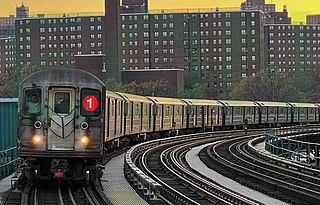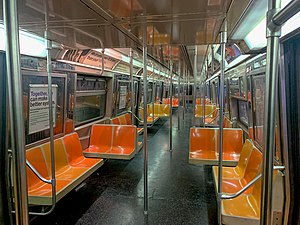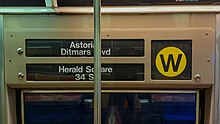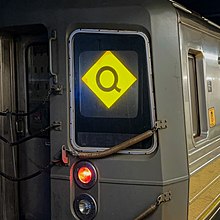
The New York City Subway is a rapid transit system in the New York City boroughs of Manhattan, Brooklyn, Queens, and the Bronx. It is owned by the government of New York City and leased to the New York City Transit Authority, an affiliate agency of the state-run Metropolitan Transportation Authority (MTA). Opened on October 27, 1904, the New York City Subway is one of the world's oldest public transit systems, one of the most-used, and the one with the most stations, with 472 stations in operation.

The Franklin Avenue Shuttle is a New York City Subway shuttle service operating in Brooklyn. The shuttle service uses the BMT Franklin Avenue Line exclusively. The north terminus is Franklin Avenue, with a transfer available to the IND Fulton Street Line. The south terminus is Prospect Park, with a transfer available to the BMT Brighton Line. NYCT Rapid Transit Operations refer to it internally as the S or FS. Like the other two shuttles, the 42nd Street Shuttle in Manhattan and the Rockaway Park Shuttle in Queens, its route bullet is colored dark gray on route signs, station signs, rolling stock, and the official subway map.

The R32 was a New York City Subway car model built by the Budd Company from 1964 to 1965 for the IND/BMT B Division. A total of 600 R32s were built, numbered 3350–3949, though some cars were re-numbered. The R32 contract was divided into two subcontracts of 300 cars each: R32 and R32A ; the former was paid by the city's capital budget and the latter was paid through a revenue bond. All were arranged as married pairs.

The R142 is the first mass-produced model class of the newest generation or new technology (NTT) A Division cars for the New York City Subway. It was built by Bombardier Transportation in La Pocatière, Quebec, Canada and Barre, Vermont, U.S. with final assembly performed at Plattsburgh, New York, from 1999 to 2003. There are 880 cars numbered 6301–7180 and another 150 cars numbered 1101–1250, for a total of 1,030 cars, all arranged as five-car sets. Together with the R142As, they replaced the Redbird trains, including the R26, R28, R29, R33, R33S, and R36.

The R142A is the second order of new technology cars (NTTs) for the A Division of the New York City Subway. These cars were built by Kawasaki Heavy Industries in the U.S. at Yonkers, New York and Lincoln, Nebraska, and in Japan at Kobe, Hyōgo. They replaced the Redbird trains, including the R26, R28, R29, R33, R33S, and R36. The R142A fleet initially comprised 600 cars, arranged as five-car units.

The R46 is a New York City Subway car model that was built by the Pullman Standard Company from 1975 to 1978 for the IND/BMT B Division. They replaced all remaining Arnine cars and General Electric-powered R16s, and some R10s. The R46 order initially consisted of 754 single cars, each 75 feet (23 m) long, and was the largest single order of passenger cars in United States railroad history at the point of the fleet's completion. The R46 was the second order of 75-foot cars to be ordered for the New York City Subway, after the R44s.

The R44 is a New York City Subway car model built by the St. Louis Car Company from 1971 to 1973 for the B Division and the Staten Island Railway (SIR). The cars replaced many R1-R9 series cars, and all remaining 1925 Standard Steel built SIRTOA ME-1 trains, providing Staten Island with a new fleet of railcars. The R44 fleet originally consisted of 352 cars, of which 57 remain in service, all on the Staten Island Railway.

The R42 was a New York City Subway car model built by the St. Louis Car Company between 1969 and 1970 for the IND/BMT B Division. There were 400 cars in the R42 fleet, numbered 4550–4949. It was the last 60-foot (18.29 m) B Division car built for the New York City Subway until the R143 in 2001, and the last car model class to be built in married pairs.

The R62 is a New York City Subway car model built between 1983 and 1985 by Kawasaki Heavy Industries in Kobe, Japan, for the A Division. A total of 325 cars were built, originally as single units. When the reliability of the fleet improved, they were converted to five-car sets. The cars replaced the remaining R12s, R14s, and R15s, which were all retired by the end of 1984.

The New York City Subway is a large rapid transit system and has a large fleet of rolling stock. As of November 2016, the New York City Subway has 6418 cars on the roster.

The R68A is a B Division New York City Subway car order consisting of 200 cars built between 1988 and 1989 by Kawasaki Railcar Company in Kobe, Japan, with final assembly done at the Kawasaki plant in Yonkers, New York. A total of 200 cars were built, arranged in four-car sets.

The R110B was a prototype class of experimental New Technology Train (NTT) New York City Subway cars built by Bombardier of Canada for service on the B Division services. There were nine cars, arranged as three-car sets. They were designed to test features that would be implemented on future mass-production NTT orders.

The R110A was a New York City Subway car model built by Kawasaki Heavy Industries in 1992 as a prototype New Technology Train to test various technologies. There were ten cars arranged as five-car sets. They were designed to test features that would be implemented on future mass-production New Tech Train orders.

The R62A is a New York City Subway car model built between 1984 and 1987 by Bombardier Transportation for the A Division. The cars were built in La Pocatière, Quebec, with final assembly done in Auburn, New York and Barre, Vermont, under a license from Kawasaki Heavy Industries, manufacturer of the previous R62 order. A total of 825 cars were built, arranged as sets of three, four, or five cars per set. The cars replaced the remaining R17s, R21s, and R22s, which were all retired by early 1988.

The R143 is a class of New Technology Train subway cars built by Kawasaki Rail Car Company for the New York City Subway's B Division. Delivered between 2001 and 2003, the cars displaced R40s and R42s that operated on the L service in conjunction with the BMT Canarsie Line's signal system being automated.

The R33 was a New York City Subway car model that was built by St. Louis Car Company in 1962 and 1963. The cars are a "follow-up" or supplemental stock for the A Division's R29s and closely resemble them. The cars were also referred to as R33MLs to distinguish them from the R33Ss. A total of 500 cars were built, numbered 8806–9305, and arranged in pairs.

The R16 was a New York City Subway car model built by the American Car and Foundry Company from 1954 to 1955 for the IND/BMT B Division. A total of 200 cars were built, arranged as single units. Two versions were manufactured: Westinghouse (WH)-powered cars and General Electric (GE)-powered cars.

The R17 was a New York City Subway car model built by the St. Louis Car Company in 1954 for the IRT A Division. A total of 400 cars were built, arranged as single units. Two versions were manufactured: Westinghouse (WH)-powered cars and General Electric (GE)-powered cars.

The R188 is a class of new technology (NTT) New York City Subway cars built by Kawasaki Heavy Industries for the A Division. The fleet entered service in 2013, displacing the 1980s-era R62A cars that operated on the 7 and <7> services, in conjunction with the automation of the IRT Flushing Line's signal system with communications-based train control (CBTC). The R188 order also expanded the 7's fleet as part of the 7 Subway Extension, which opened in 2015.

New Technology Train (NTT) is the collective term for the modern passenger fleet of the New York City Subway that has entered service since the turn of the 21st century. This includes the current R142, R142A, R143, R160, R179, R188 and R211 models, along with the planned R262 and R268 models. Two prototypes, the R110A and R110B, were used to test the features that would be found on all NTT trains today.






















